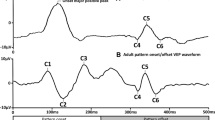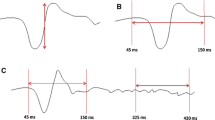Abstract
The results of motion-onset visual evoked potentials and pattern-reversal visual evoked potentials were compared in 5 adults with amblyopia, in 13 patients with unilateral retrobulbar neuritis and in 62 patients with multiple sclerosis. While the pattern-reversal visual evoked potentials had reduced amplitudes and prolonged latencies in all amblyopic eyes, the motion-onset visual evoked potentials were normal. Thus, motion-onset visual evoked potentials cannot be used for diagnosis of amblyopia. In patients with retrobulbar neuritis, both types of visual evoked potentials were delayed on stimulation of the affected eye. The latency increase was, however, greater for pattern-reversal visual evoked potentials than for motion-onset visual evoked potentials. Examination of the patients with multiple sclerosis showed that the additional use of motion-onset visual evoked potentials increased the sensitivity of the investigation. In some patients, only the motion-onset visual evoked potentials had pathologic latency increases, whereas the pattern-reversal visual evoked potentials stayed within normal limits.
Similar content being viewed by others
References
Spehlmann R. Evoked potential primer: Visual, auditory, and somatosensory evoked potentials in clinical diagnosis. Stoneham, Mass: Butterworth Publishers, 1985: 85–7.
Kuba M, Kubová Z. Visual evoked potentials specific for motion-onset. Doc Ophthalmol 1992; 80: 83–89.
Kubová Z, Kuba M, Vít F, Peregrin J. Properties of movement on related VERs. Doc Ophthalmol 1990; 75: 67–72.
Markwardt F, Göpfert E, Müller R. Influence of velocity, temporal frequency and initial phase position of grating patterns on motion VEP. Biomed Biochim Acta 1988; 47: 753–60.
Arden GB, Barnard WM. Effect of occlusion on the visual evoked response in amblyopia. Trans Ophthalmol Soc UK 1979; 99: 419–26.
Mayeles WP, Moulholand WV. The response to pattern reversal in amblyopia. In: Gracco RQ, Bodis Wollner I, eds. Evoked potentials. New York: Alan R. Liss Inc, 1986: 243–50.
Levi DM, Manny Ruth E. The VEPs in the diagnostic evaluation of amblyopia. In: Gracco RQ, Bodis Wollner I, eds. Evoked postentials. New York: Alan R. Liss Inc, 1986: 437–46.
Sokol S. Clinical application of the ERG and VEPs in the pediatric age group. In: Gracco RQ, Bodis Wollner I, eds. Evoked potentials. New York: Alan R. Liss Inc, 1986: 447–55.
Halliday AM, McDonald WI, Mushin J. Delayed visual evoked responses in optic neuritis. Lancet 1972; i: 982–5.
Cox TA, Thompson HS, Hayereh SS, Snyder JE. Visual evoked potential and pupillary signs. A comparison in optic nerve disease. Arch Ophthalmol 1982; 100: 1603–7.
Sanders EACM, Volkers ACW, Van der Poel JC, Van Lith GHM. Visual function and pattern visual evoked response in optic neuritis. Br Ophthalmol 1987; 71: 602–8.
Brecelj J, Kriss A Pattern reversal VEPs in optic neuritis. Advantages of central and peripheral half-field stimulation. Neuro-ophthalmology 1989; 9: 55–63.
Harding AM, McDonald WI, Mushin J. Visual evoked potentials in patients with demyelinating disease. In: Desmedt JE, ed. Visual evoked potentials in man. New develop- ments. Oxford, England: Clarendon Press, 1977: 438–49.
Koerner E, Ladurner G, Flooh E, Reinhart B, Wolf R, Lechner H. Änderungen der Muster-evozierten Potentiale bei multipler Sklerose im Zusammenhang mit dem zietlichen Ablauf der Erkrankung. Z EEG-EMG 1982; 13: 73–6.
Matthews WB, Wattam-Bell JRB, Pountney E. Evoked potentials in the diagnosis of multiple sclerosis: A follow up study. J. Neurol Neurosurg Psychiatry 1982; 45: 303–7.
Oepen G, Brauner C, Doerr M, Thoden W. Visual evoked potentials elicited by checkerboard versus foveal stimulation in multiple sclerosis. Arch Psychiatr Nervenkr 1981; 229: 305–13.
Celesia GG, Kauffmann D, Cone S. Simultaneous recording of pattern electroretinography and visual evoked potentials in multiple sclerosis: A method to separate demyelinization from axonal damage to optic nerve. Arch Neurol 1986; 43: 1247.
Paty DW, Oger JJF, Kastrukoff LF, Hashimoto SA, Hooge JP, Eisen AA, Eisen KA, Purves SJ, Low MD, Brandejs V, Robertson WD, Li DKB. MRI in the diagnosis of MS. A prospective study with comparison of clinical evaluation, evoked potentials, oligoclonal banding, and CT. Neurology 1988; 38: 180–5.
Altenmüller E, Diener HC, Dichghans J. Visuel evozierte potentiale. In: Stöhr M, Dichghans J, Buettner UW, eds. Evozierte potenciale. Berlin: Springer Verlag, 1989: 279–379.
Lennie P, Trevarthen C, Van Essen D, Wässle A. Parallel processing of visual information. In: Spillmann L, Werner JS, eds. Visual perception: The neurophysiological foundations. San Diego: Academic Press, 1990: 103–28.
Wald G, Burian HM. The dissociation of form vision and light perception in strabismic amblyopia. Am J Ophthalmol 1944; 27: 950–63.
Feinsod M, Abramsky O, Auerbach E. Electrophysiological examination of the visual system in multiple sclerosis. J Neurol Sci 1973; 20: 161–75.
Hennerici M, Wenzel D, Freund HJ. The comparison of small-size rectangle and checkerboard stimulation for the evaluation of delayed visual evoked responses in patients suspected of MS. Brain 1977; 100: 119–36.
Gerhard H, Jörg J, Friesacher H. Zerebrale Refraktörperiod des VEP nach Ganzfeld- und fovealer Stimulation. Z EEG-EMG 1985; 16: 81–6.
Author information
Authors and Affiliations
Rights and permissions
About this article
Cite this article
Kubová, Z., Kuba, M. Clinical application of motion-onset visual evoked potentials. Doc Ophthalmol 81, 209–218 (1992). https://doi.org/10.1007/BF00156010
Accepted:
Issue Date:
DOI: https://doi.org/10.1007/BF00156010




